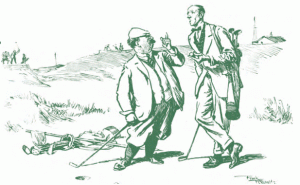 By Bert Jones USGTF Master Golf Teaching Professional Loomis, California
By Bert Jones USGTF Master Golf Teaching Professional Loomis, California
Have you ever wondered why some people can move from their current situation to a stated goal and some people can’t? Is it a matter of applied will, or just having enough knowledge?
If we reflect on the last 40 years, we have little to no improvement in the average golf score. In fact, professional averages are relatively stagnant, also! How can this be, even with the advent of new equipment, better agronomy, and the state of instruction using space-age technology for analysis?
Perhaps we can start by looking at how goals are developed. When developing a goal, it should follow the acronym SMART. The SMART acronym stands for specific, measurable, agreed upon, realistic and time-based. Every goal will be based on one of three words: desire, want, and need. Each of these words is different and requires thoughtful consideration. Clarity around need, want and desire will provide you a vision of the goal.
Achieving goal specificity can be an elusive proposition. How many times have you had a student tell you that they “want” to improve their putting? Sounds pretty vague to me! To putt “better” requires analysis of where the student is with their knowledge, skill and ability. I normally put my students through an array of tests such as the Titleist Performance Institute LORD’s test or the Eyeline Skill Test (both of which can be found online) to determine a benchmark. Once the evidenced-based benchmark is achieved, I can then begin to assist the student’s specific goal.
An example of a specific goal could be to reduce the number of three-putts from four per round to two per round over a period of 45 days. The goal is measureable because we have created a starting and ending point over a period of time. It is critical that the goal be agreed upon, as the goal should be intrinsic by nature. The goal should be realistic as it is based upon a benchmark analysis of the player.
Sounds pretty simple, right? If it was, then we would have a nation of high achievers, and we know that is not the case. So why do so many good intentions fall short? Is it bad goal setting or just lack of will?
Perhaps the answer can be found in instruction and motor programming! Most students that I have encountered do not fully understand putting or their equipment. Their skill, knowledge and ability have to be built or reformed. In addition, I have found that many students don’t know how to practice. They think they do, but they don’t.
Explanation, demonstration, observation and correction on identified sub-elements help students understand how to practice. I like to have students use guidance devices to provide feedback when I am not able to stand and observe the player between lessons. A limited amount of drills are prescribed to ensure that students are working on changing their habits.
It is important to understand that habits are changed through ritual. Creating rituals in the pre- and post-routine are the means to integrating new neural pathways in the brain to create better performance. Visit the “Human Performance Institute” online for a deeper understanding of rituals and habit development.
No more three-putts!
Copyright © 2023 United States Golf Teachers Federation, All Rights Reserved
200 S. Indian River Drive, Suite #206, Fort Pierce, FL 34950
772-88-USGTF or 772-595-6490 - www.usgtf.com
200 S. Indian River Drive, Suite #206, Fort Pierce, FL 34950
772-88-USGTF or 772-595-6490 - www.usgtf.com
